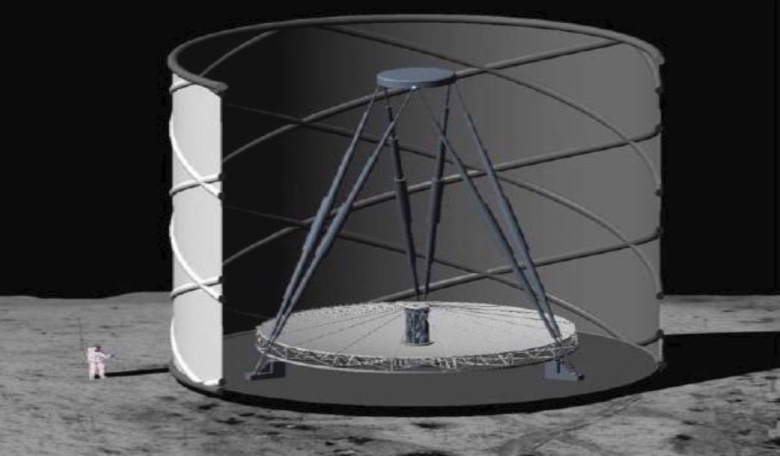When it comes to telescope naming conventions in astronomy, you could wonder what would follow the “Extremely Large Telescope”, an observatory with a 39 metre-diameter mirror being built in Chile. It turns out, a decade ago, NASA had already thought up the “Ultimately Large Telescope,” - a sizeable liquid mirror telescope that would located on the Moon. Now, a group of astronomers from The University of Texas at Austin would like to revive the idea so that they could study the first stars in the Universe.
Building a telescope on the Moon might seem an audacious project and one that is possibly out of reach of science for the foreseeable future, but it is not the first time an observatory on the Moon has been proposed.
Earlier this year NASA awarded a grant for the development of the Lunar Crater Radio Telescope (LCRT) – a wire-mesh receiver one kilometre in diameter that would sit inside a large lunar crater.
Long before this idea, the US space agency had already considered a highly-reflective 20 metre telescope that would operate from the surface of the Moon, following a proposal originally outlined in 2008 by Roger Angel and collaborators.
Devised initially to carry out deep infrared surveys to study the distant Universe, the UHT would be able to observe Population III stars, the first stars which formed about 13 billion years ago.
These distinct type of stellar object are born out of a mix of hydrogen and helium gasses, and are likely tens or 100 times larger than the Sun. Despite their size, they are so distant from us, that not even NASA’s latest technologically advanced telescope, the powerful but problem-prone James Webb Space Telescope, would be able to detect them.
“Throughout the history of astronomy, telescopes have become more powerful, allowing us to probe sources from successively earlier cosmic times — ever closer to the Big Bang,” said professor Volker Bromm, a theorist who has studied the first stars for decades.
“The upcoming James Webb Space Telescope [JWST] will reach the time when galaxies first formed. But theory predicts that there was an even earlier time, when galaxies did not yet exist, but where individual stars first formed — the elusive Population III stars. This moment of ‘very first light’ is beyond the capabilities even of the powerful JWST, and instead needs an ‘ultimate’ telescope,” added Bromm, who is also a co-author on a recent research paper describing the possibilities of the ULT.
Webb will be able to see what the Universe looked like around a quarter of a billion years after the Big Bang, but a lunar liquid-mirror telescope has the potential to detect objects 30 –1000 times fainter than the deep images provided by the space telescope.
So how would the “Ultimately Large Telescope” work?
Rather than being coated in glass, the telescope’s mirror would be a spinning vat of liquid, topped by a metallic (and thus reflective) liquid.
The vat would spin continuously, to keep the surface of the liquid in the correct paraboloid shape to work as a mirror. Furthermore, the ULT would be situated inside a crater at the Moon’s north or south pole, say the team interested in reviving the project.
The team, headed by Anna Schauer, envisage that the liquid mirror should be increased from its initial 20 metre design to 100 metres, and even though it would be substantial larger, as the “mirror” is made of liquid it would be lighter, and therefore cheaper to transport to the Moon.
The Texan team suspect that the very first stars will have a unique signature that will make them easier to distinguish from other objects but to catch a glimpse of them, the ULT would have to stare at the same patch of sky continuously, to collect as much light from them as possible.
“We live in a universe of stars,” Bromm said. “It is a key question how star formation got going early in cosmic history. The emergence of the first stars marks a crucial transition in the history of the universe, when the primordial conditions set by the Big Bang gave way to an ever-increasing cosmic complexity, eventually bringing life to planets, life, and intelligent beings like us.”
As promising as the ULT sounds, what is the likelihood that a project of this scope could get the go-ahead?
NASA, having done an analysis on this proposed facility a decade ago, decided not to pursue the project at the time.
But, says Niv Drory, a senior research scientist with UT Austin’s McDonald Observatory, the supporting science on the earliest stars did not exist at that point and this telescope is “perfect for that problem,” he said.
With a chance to study the entire cosmic star formation history, Schauer, Drory and Bromm, are proposing that the astronomical community revisit this shelved plan for a lunar liquid-mirror telescope. This would complete astronomy’s centuries old pursuit to “push the frontier of the observable universe,” the team say.











